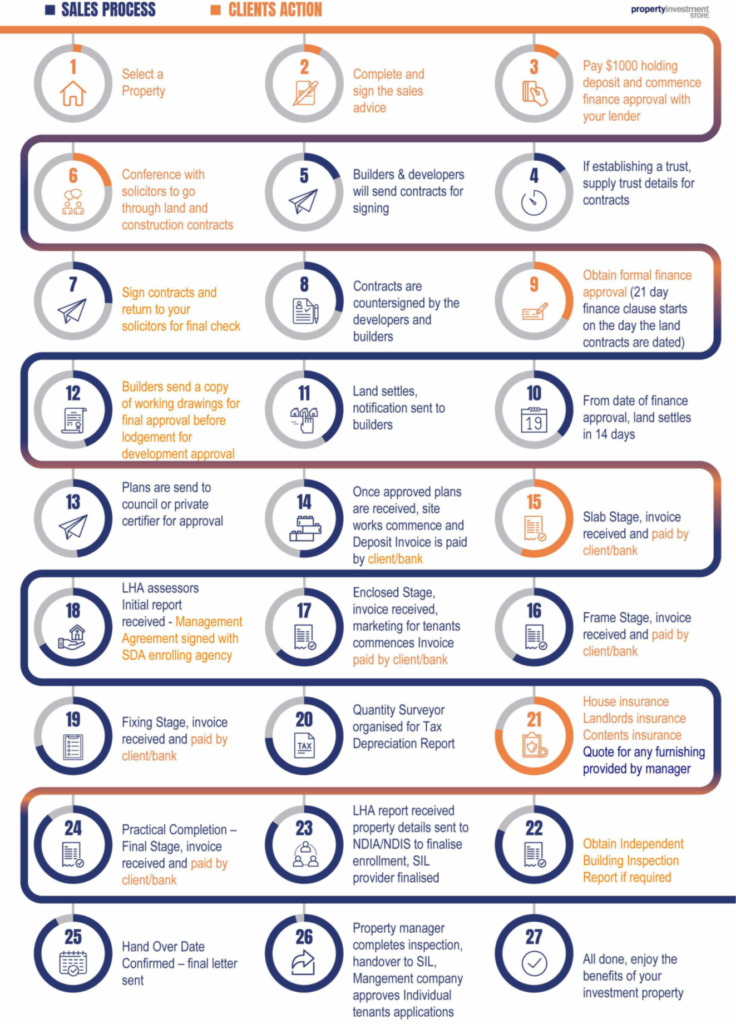How Does the NDIS Benefit Property Investors?
The National Disability Insurance Scheme (NDIS) offers a unique investment opportunity through the Specialist Disability Accommodation (SDA) funding scheme. This initiative provides accessible housing for Australians with disabilities, combining social impact with financial rewards for property investors. Here’s how investing in SDA properties can be advantageous:
1. Secure, Long-Term Government Backing
- 20-Year Rental Guarantee: The Australian government provides a stable income stream through SDA funding, offering a secure investment environment.
- Growing Funding Commitment: The NDIS budget is set to increase from $41.9 billion in 2023/24 to $89.4 billion by 2031/32, highlighting the long-term stability of the scheme.
2. High Market Demand for SDA Properties
- Undersupply of Suitable Housing: Currently, over 14,000 NDIS participants live in inappropriate accommodation, such as aged care, government housing, or unsuitable family homes.
- Projected Need: With 30,000 participants eligible for SDA and only 1,800 new places built in 2020, the demand for new, purpose-built SDA housing remains high.
- Replacement of Old Stock: Many existing SDA properties are outdated, creating additional demand for contemporary, compliant housing.
3. Financial Benefits for Investors
Attractive Rental Yields
- High Returns: SDA properties can offer gross rental yields of 10% to 25%, with net returns averaging 8-15% per annum.
- Revenue Streams: Investors benefit from:
- SDA Payments from the NDIS
- Reasonable Rent Contributions (RRC) from tenants
- Commonwealth Rent Assistance
Investment Costs
- Property Prices: SDA properties typically range from $500,000 to $900,000, depending on location, land prices, and the inclusions needed for different SDA categories.
4. Building SDA Properties: Quality and Compliance
- Build Quality: Good builders adhere to NDIS SDA standards and Livable Housing Australia (LHA) guidelines, ensuring homes are fit for purpose.
- Construction Timeline: Building an SDA-approved home takes approximately 10-12 months.
- Builder’s Warranty: Structural warranties typically last 6-7 years, with a 6-12 month maintenance period for fixtures and fittings.
5. Location Considerations for SDA Investments
- Proximity to Amenities: Ideal SDA homes are near transport, healthcare, employment hubs, and community facilities.
- Land Suitability: The land must meet specific criteria, such as limited slope and accessibility to essential services.
6. Overcoming Construction Challenges
Higher Building Costs
- Special Features Required: SDA homes often include larger floor plans, stronger materials, and advanced automation (e.g., lighting, windows, doors).
- Customization Needs: Each SDA category (e.g., Robust, High Physical Support) requires specific features that increase construction costs.
7. Navigating SDA Compliance and Certification
Certification Process: SDA properties undergo certification at multiple stages:
- Planning Stage: Initial SDA certification before land and build contracts.
- Construction Stage: Certification at the frame stage to match approved plans.
- Completion Stage: Final certification upon practical completion, necessary to receive SDA funding.
Accredited SDA Assessors: Certification must be conducted by professionals such as:
- Building Surveyors
- Architects
- Occupational Therapists
- Access Consultants
8. Management and Operation of SDA Properties
- SDA Providers Handle Operations: These companies manage tenancy, collect SDA payments, and handle maintenance, offering a hands-off investment experience.
- Turnkey Investment: SDA homes are delivered as fully finished, ready-to-rent properties, eliminating hidden costs often associated with traditional builds.
9. Flexible Exit Strategy
- After 20 Years: Investors can sell the property under standard real estate laws or continue under the NDIS as existing SDA stock.
- Versatility: With minor modifications, SDA homes can convert to standard residential properties, broadening resale opportunities.
10. Renovating Existing Homes for SDA Compliance
- Eligibility Requirements: Only properties with occupancy certificates issued after April 1st, 2016 are eligible.
- Refurbishment Standards: Renovations must meet the NDIS Pricing Arrangements and Design Standards, often making new builds a more viable option.
11. Additional SDA Funding Options: Onsite Overnight Assistance (OOA)
- What is OOA? An additional room in SDA properties for support staff, enhancing property eligibility for additional funding.
- Location Requirements: OOA rooms must be accessible to participants and comply with NDIS design standards.
Conclusion: Why Invest in SDA Properties?
Investing in SDA properties under the NDIS scheme is not only a financially sound decision but also a meaningful contribution to the community. The combination of high rental yields, government-backed security, and the positive social impact makes SDA property investment a unique and valuable opportunity for investors looking for both profitability and purpose.

